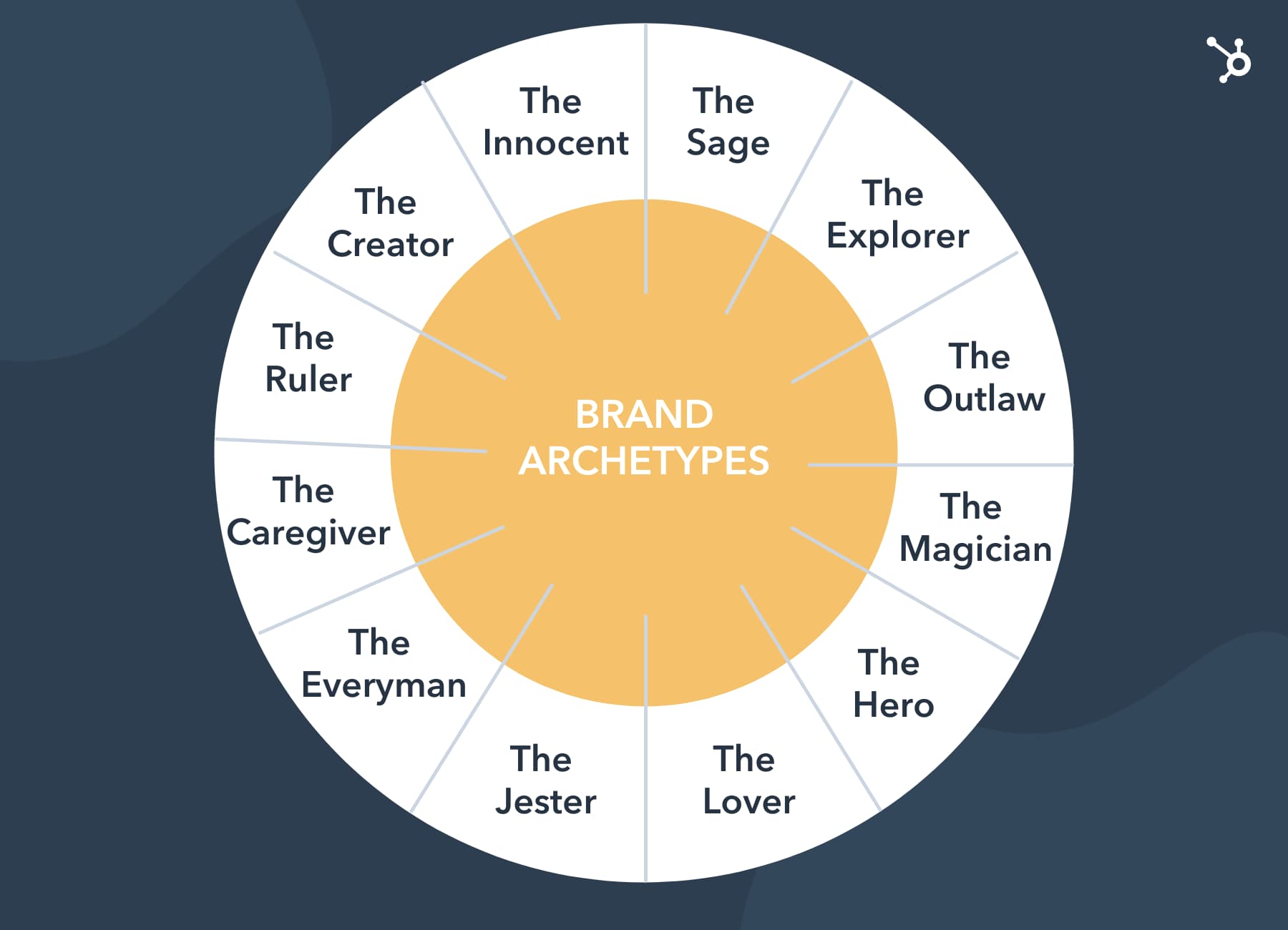When I start a TV show, I immediately try to identify each archetype.
Who’s the protagonist? Who’s the villain? Who’s the unsung hero saving the day at the last minute? Sometimes, it’s clear from the very beginning and others, you can’t tell until the very last scene.
The point is that these archetypes are universally known personas that are used to tell a story. They help us as viewers understand what’s going on and help us get emotionally invested in the characters.
In real life, brands use archetypes to shape their narrative. Let’s cover the 12 brand archetypes, how to define yours, and review some examples from popular brands today.
The archetype model is credited to Author and Thought Leader Carol S. Pearson, who outlined the 12 archetypes in her book “Awakening the Heroes Within.”
An archetype is more than just a persona or character – it’s tied to a larger theme, concept, or emotion that transcends time and culture.
For instance, everyone, regardless of culture or generation, can identify with the concept of a hero. Brands like Nike embody that archetype because it tells a scalable and sustainable story, tapping into human nature.
It’s easy to confuse a brand archetype with a brand identity. While the two may seem similar in concept, their compositions are completely different.
Your brand identity is a holistic view of how your brand presents itself to the world, from logos and colors to messaging and promises. An archetype, on the other hand, is the personification of your brand values, mission, and story.
In simpler terms, your identity says “Here I am.” Your archetype says, “Here’s my story.”
Why should you use brand archetypes?
Brand archetypes are helpful for all brands, regardless of size and success.
For emerging companies, an archetype can help mold your brand perception. Because an archetype is tied to a theme, it’s easier for consumers to wrap their heads around.
Too often, brands seem far away from their target audience. An archetype can help bridge that gap and create an emotional tie between you and your audience.
Now let’s say you’re an established brand that’s having trouble connecting with its target audience. In this case, building an archetype can help you create a narrative around your brand that your audience can rally behind.
In addition, archetypes help you set expectations for interactions with your brand at every touchpoint.
Brand Archetypes Wheel

- The Innocent craves safety and looks at things from a glass half full. The main themes for this archetype are happiness, trust, and purity.
- The Sage craves understanding. For them, the pursuit of knowledge is the priority. Education-focused companies, like Coursera and Discovery, typically exhibit this archetype.
- The Explorer craves freedom. With this archetype, it’s all about what’s daring and exciting. Think of outdoor and adventure brands.
- The Outlaw craves liberation. They believe in the saying, “Rules are made to be broken.” The main themes for this archetype are rebellion and disruption.
- The Magician craves power. They’re dreamers who believe anything can happen. You’ll also find this often in entertainment brands as well as beauty.
- The Hero craves mastery. They don’t back down from a challenge and display courage, honesty, and bravery – a common archetype in sportswear brands.
- The Lover craves intimacy and focuses heavily on the senses. Popular lover archetypes are found in indulgent brands like chocolate, wine, fragrance, and cosmetics.
- The Jester craves enjoyment. They bring the fun to the party every time, and they’re not afraid of a little mischief.
- The Everyman craves belonging. They are warm, friendly, and humble. This is perhaps the most flexible archetype and you can see it in a variety of industries.
- The Caregiver craves service. The main theme of this archetype is altruism. Nonprofit and sustainability brands depict this archetype often.
- The Ruler craves control. They value organization, power, and status. You’ll often notice this archetype in luxury vehicle brands.
- The Creator craves innovation. They’re bold, creative, and aren’t afraid to try new things. Technology brands like Apple and Adobe are perfect examples of this archetype.
How to Define and Create Your Brand Archetype
1. Look at your values and mission.
The industry you’re in may inform how easy it is for you to define your archetype.
For instance, if you’re a camping gear company, your archetype can easily tie back to the “Explorer” archetype, as that’s all about adventure. Or if you’re a non-profit, the “Caregiver” is a natural fit. However, it’s not always that easy.
In most cases, you’ll have to dig deep and refer to your values and mission statement for some direction. They serve as the thematic pillars of your brand and will help you determine which archetype fits you best.
For instance, say you’re a jewelry brand with a sell-one-give-one model and your mission is to empower
They tell us the “why” behind your business. Perhaps it’s sustainability, empowerment, celebration, or something entirely different.
Answering these questions will help you determine which archetype makes the most sense for your brand.
2. Build on emotion.
We know through research that emotional appeal works. And storytelling is the perfect vehicle for conveying emotion.
That’s why archetypes can be so successful — they’re tied to emotion.
With that in mind, consider what emotions you want your audience to feel when connecting with your brand.
Chocolate is often associated with love. As such, many chocolate brands embrace the “Lover” archetype and create commercials that emphasize texture, building sensory experiences.
That leads us to the next tip below.
3. Think of your audience.
While your brand archetype can be strongly influenced by your company values and mission, it’s also important to consider your audience in this process.
Will they connect with this archetype? Do they see themselves in it? How will they respond?
Asking these questions will help you shape your brand archetype and mold it to fit your target audience.
For instance, you might find that your brand displays both “Jester” and “Everyman” archetype qualities. However, based on your understanding of your audience, you may decide to lean more on one for a particular campaign.
If your company is going through a rebranding process, you may also reconsider which brand archetype fits your brand the best.
Brand Archetypes Examples
1. Godiva
This one is an easy one.
Godiva is a chocolate brand that represents the “Lover” archetype.
Their brand, as reflected in their commercials, is all about intimacy, indulgence, and feeling the senses.
Take this commercial.
It’s filled with pinks and reds, colors commonly associated with sensuality and intimacy. The shots play with different textures meant to arouse the senses.
And if by the end of the commercial, you’re still not clear on the archetype, they lay it out in the tagline: “Chocolate never felt so good.”
2. Hanahana Beauty
Brands that are socially conscious often fit into the “Caregiver” archetype. Hanahana Beauty is no different.
This beauty and wellness brand has a clear mission: Disrupt the beauty industry with clean products and sustainable practices that improve the shea trade.
In their latest video ad, Hanahana Beauty introduces a new product called “skin nutrition.”
One standout line from the ad is this: “For me, one thing you can do to show love is through giving.”
The narrator goes on to say that self-love is also a form of giving, it’s giving to yourself.
Overall, the ad is inviting and warm – mirroring the archetype beautifully.
3. Saysh
“Like so many of us, I was told to know my place.”
When you hear this quote from Olympian and Saysh founder Allyson Felix in the company launch ad, you’re immediately invested in her story.
This ad tells the story of a “Hero” archetype, facing challenges and addressing them head-on. Felix explains how her journey as a female athlete and mother showed her that her biggest competitor is inequality.
With her brand, she fights against it.
It’s everything you expect in a hero archetype: Candid, brave, and inspiring.
4. Netflix
If you follow this streaming channel on any social media platform, you probably would have already guessed that they follow the “Jester” archetype.
Whether it’s in a Tweet or in an ad, Netflix relies heavily on humor to attract and captivate its audience.
The brand is based entirely on enjoyment – specifically sitting back and relaxing to watch your favorite TV show or movie. So, it’s only right that their archetype match.
If you want to create video commercials like these based on your brand archetypes, consider tools like Wistia, Vidyard, and Hippo Video. These tools help you create high-quality videos to reach audiences in both B2B and B2C.
Building your brand archetype is just another way to connect with your audience. As your brand evolves, many things may change, including your products or services, your messaging, and even your target audience. Your archetype ensures that you tell a story that can resonate with any consumer.
![]()


